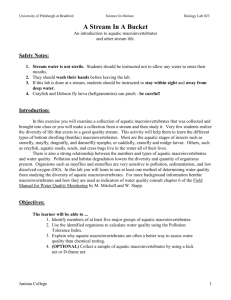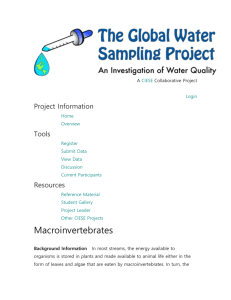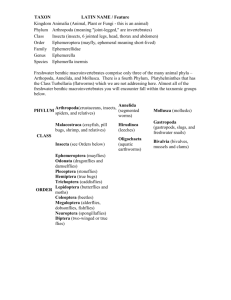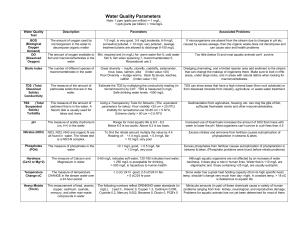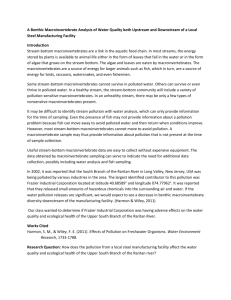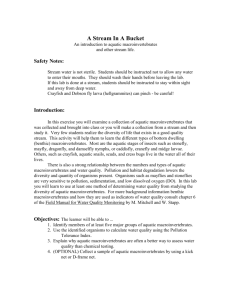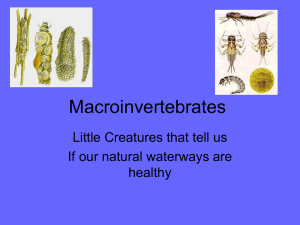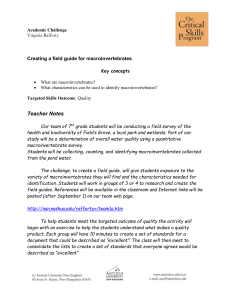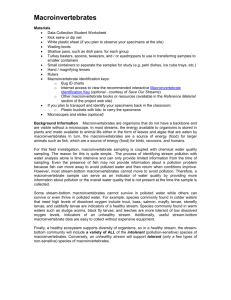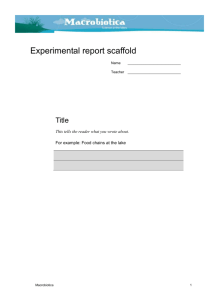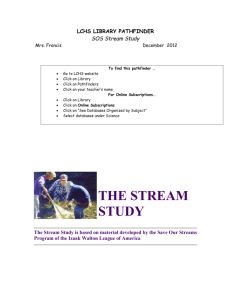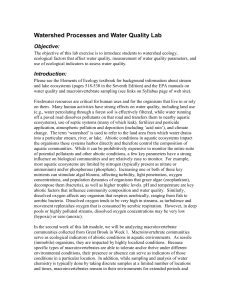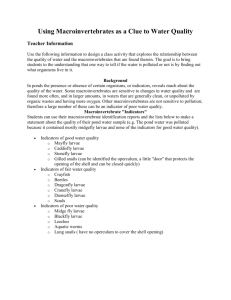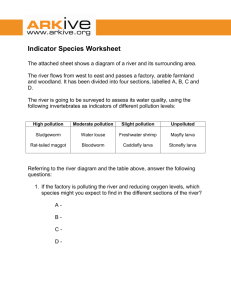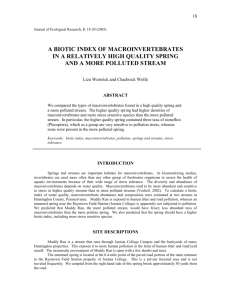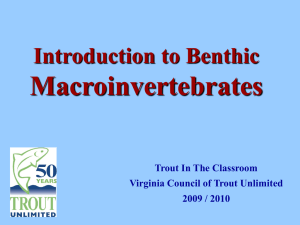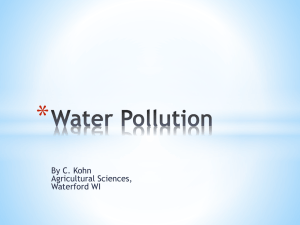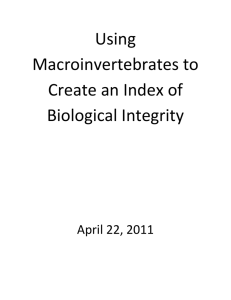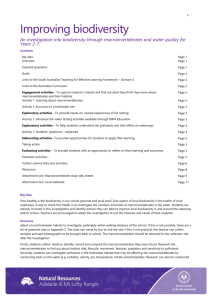Why are Macroinvertebrates important to the aquatic ecosystem?
advertisement
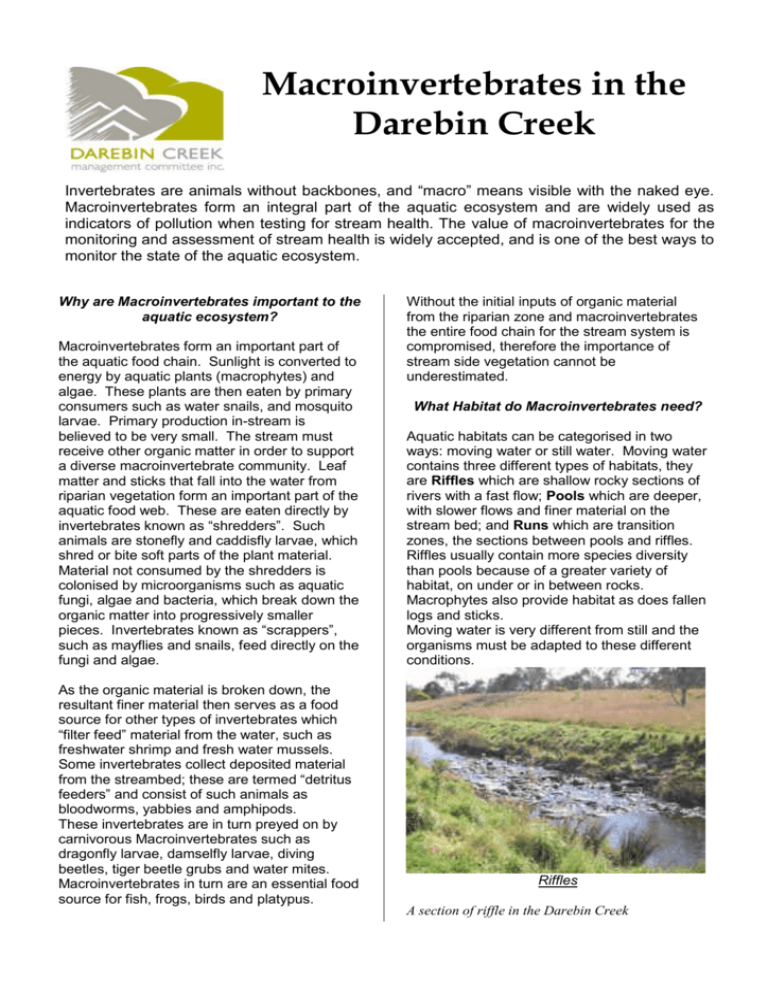
Macroinvertebrates in the Darebin Creek Invertebrates are animals without backbones, and “macro” means visible with the naked eye. Macroinvertebrates form an integral part of the aquatic ecosystem and are widely used as indicators of pollution when testing for stream health. The value of macroinvertebrates for the monitoring and assessment of stream health is widely accepted, and is one of the best ways to monitor the state of the aquatic ecosystem. Why are Macroinvertebrates important to the aquatic ecosystem? Macroinvertebrates form an important part of the aquatic food chain. Sunlight is converted to energy by aquatic plants (macrophytes) and algae. These plants are then eaten by primary consumers such as water snails, and mosquito larvae. Primary production in-stream is believed to be very small. The stream must receive other organic matter in order to support a diverse macroinvertebrate community. Leaf matter and sticks that fall into the water from riparian vegetation form an important part of the aquatic food web. These are eaten directly by invertebrates known as “shredders”. Such animals are stonefly and caddisfly larvae, which shred or bite soft parts of the plant material. Material not consumed by the shredders is colonised by microorganisms such as aquatic fungi, algae and bacteria, which break down the organic matter into progressively smaller pieces. Invertebrates known as “scrappers”, such as mayflies and snails, feed directly on the fungi and algae. As the organic material is broken down, the resultant finer material then serves as a food source for other types of invertebrates which “filter feed” material from the water, such as freshwater shrimp and fresh water mussels. Some invertebrates collect deposited material from the streambed; these are termed “detritus feeders” and consist of such animals as bloodworms, yabbies and amphipods. These invertebrates are in turn preyed on by carnivorous Macroinvertebrates such as dragonfly larvae, damselfly larvae, diving beetles, tiger beetle grubs and water mites. Macroinvertebrates in turn are an essential food source for fish, frogs, birds and platypus. Without the initial inputs of organic material from the riparian zone and macroinvertebrates the entire food chain for the stream system is compromised, therefore the importance of stream side vegetation cannot be underestimated. What Habitat do Macroinvertebrates need? Aquatic habitats can be categorised in two ways: moving water or still water. Moving water contains three different types of habitats, they are Riffles which are shallow rocky sections of rivers with a fast flow; Pools which are deeper, with slower flows and finer material on the stream bed; and Runs which are transition zones, the sections between pools and riffles. Riffles usually contain more species diversity than pools because of a greater variety of habitat, on under or in between rocks. Macrophytes also provide habitat as does fallen logs and sticks. Moving water is very different from still and the organisms must be adapted to these different conditions. Riffles A section of riffle in the Darebin Creek Organisms living in moving water must be able to ‘hang on’ to rocks and plant matter to avoid being swept away. They tend to have streamlined bodies and special hooks or suction type attachment structures, for example damselfly larvae are streamlines with ‘hooks’, and leeches and snails have suction attachments. Because these animals don’t move much, locomotion is limited to creeping. These types of Macroinvertebrates consume food that is either filtered out of the water or grabbed as it passes. Those that grab often have specialised front legs and mouthparts for feeding. Pools or wetlands Macroinvertebrates found in slow or still water do not have special adaptations to hang on, their foods does not come to them, they go to it. These types of organisms are not stream lined and are adapted to move. There are a wider range of sizes and shapes amongst organisms in still or slow water compared to fast moving water. Examples of animals that live in slow moving water are water mites, amphipods and different types of water bugs. Macroinvertebrates as indicators of pollution Macroinvertebrates are useful indicators of stream health because: they occupy a central role in the food chains of aquatic systems; many live in the water for over a year; they cannot easily escape pollution (as some fish can); and are sensitive to even quite mild pollutants or changes in water quality. They are also relatively easy and inexpensive to sample. The Darebin Creek Management Committee supports the Waterwatch Program which is a joint government and community program which utilises local schools and community groups to monitor water quality and report back to a waterwatch officer who can then record and keep track of local stream health. Macroinvertebrates are used as biological indicators of stream health, with their abundance and diversity being used to indicate the presence of pollution. They give us an indication of the effects of point and non-point pollution, such as nutrient, organic and toxic pollution; the effects of changes to the physical conditions of a river, such as changes in flow, vegetation, sedimentation, channelisation and erosion; and an overall water quality in the river system and thus how well the catchment is being managed. Because many live in the water for longer than a year, together with their relative lack of mobility it makes them a useful indicator of intermittent pollution. For example if a pulse of toxic waste was released into a stream it may impact on the variety and numbers of the macroinvertebrate community, which would remain evident for several months. By contrast chemical testing would only pick the toxicant up if it were present at that time. Chemical testing is conducted to confirm the presence and particular type of pollution. Different Macroinvertebrates have different tolerance levels to pollution. Macroinvertebrates are often given a ranking according to how well or badly they tolerate living in water of bad water quality. Usually the better the water quality, the greater the number of animals will be present. The tolerance levels given below is mainly based on organic pollution, such as sewage, high loads of leaf matter, dog faeces, or agricultural run-off, which causes lowered oxygen levels. The tolerance levels of the macroinvertebrate groups may vary with other forms of pollution such as toxic metals, pesticides and sediment inputs. Within the group, tolerances of individual species may vary. For further information please contact the Darebin Creek Management Committee on 9499 4454 or visit our website www.dcmc.org.au
